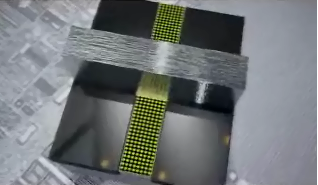Intel: Moore's Law has been cubed; Welcome to 3-D transistors

Silicon wafers historically have been two dimensional. Intel on Wednesday changed all of that with 3-D transistors, dubbed Tri-Gate. The aim: Ensure that Moore's Law, which dictates that transistor density doubles every two years, keeps chugging along.

These 3-D-based chips will first hit servers, desktops and laptops; Atom-based products will come later. Intel didn't detail exact delivery targets, but later this year is likely. The company said it expects it will have a three-year lead on rivals.
Intel first detailed 3-D transistors in 2002, and now these chips will hit the market. The general idea is to pack more computing cycles with lower power. For Intel, which demonstrated a 22nm chip, 3-D chips will allow it to move into more markets such as cars, medical devices and other devices.
At a press conference in San Francisco, Dadi Perlmutter, executive vice president of Intel's Architecture Group, said the company's move will push higher performance onto smaller devices. Devices will require "ever-increasing performance" whether you're talking servers in a data center or tablets.
Intel executives were asked about whether they can break into smartphones and tablets vs. ARM.
Perlmutter said:
"I'm not going to go into big details. This will keep us extremely competitive in traditional space and help us to move ahead farther than the ARM ecosystem."
He added that 22nm and Tri-Gate transistors will be "a wonderful tool" as the company tries to enter the smartphone and tablet market. Perlmutter added that there are "things we are trying to penetrate" and that Intel will be very competitive with ARM. Nevertheless, Perlmutter downplayed the architecture issue between x86 and ARM architecture.
It was clear that smartphone and tablet chips were all anyone wanted to talk about. Intel said it will outline more on this front at its analyst meeting.
3-D transistors have been touted by scientists for years, but the difference here is that Intel will use them in volume. Intel executives said that the company will begin revamping its plants in Arizona, Oregon and Israel to produce these 3-D chips.
In a nutshell, Intel is giving transistors "fins," which allow it to pack more power in a tight spot. Intel noted that it couldn't merely continue to shrink processors and keep Moore's Law going.
Intel likened the Tri-Gate transistors to skyscrapers, which allowed developers to optimize space by moving upward.
Among the key points:
- 3-D Tri-Gate transistors will operate at lower voltage with less leakage. The upshot is that performance will improve.
- Chip designers will be able to pick fins and choose transistors for low power or performance.
- 22nm Tri-Gate transistors will use less than half the power at the same performance as 2-D 32nm chips.
- These 3-D transistors have a 10x lower depletion rate.
- Applied to a CPU, you can have a lower clock rate with the same performance as higher speeds.